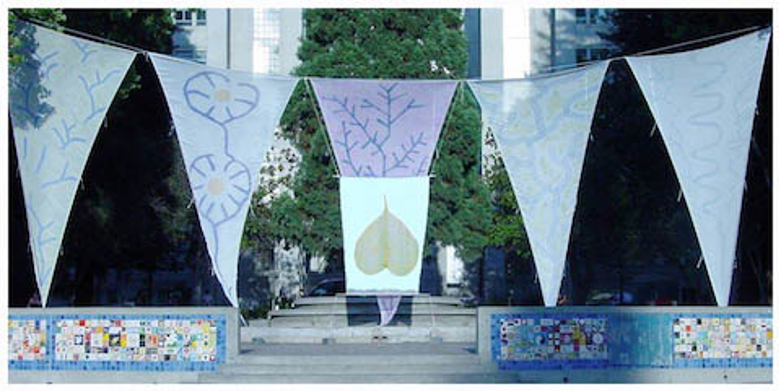Video
Watershed Environmental Poetry Festival
Objective: Inspired by artist Arthur Okamura and the Watershed Environmental Poetry Festival, students will learn about California’s water distribution and drought through the integration of science, math, and art.

20th Annual Watershed Environmental Poetry Festival
In addition to being part of the visual arts community, Arthur Okamura was friends with many Bay Area poets and even illustrated some of their books.
One of the biggest contributions Okamura made to the Bay Area poetry community was his artwork for the Watershed Environmental Poetry Festival. The Watershed Environmental Poetry Festival was born from the collaboration of poets and ecologists to discuss the topic “Nature and the American Imagination.” In 1997, Okamura was commissioned to paint large silk banners as background sets for the first Watershed Environmental Poetry Festival, held in San Francisco’s Golden Gate Park. Today, Watershed has moved its annual festival to Berkeley, California, and it continues to explore the connections between environmental awareness and the American literary imagination with ecological, cultural, and literary groups and artists, dancers, and musicians.
In this lesson, you will learn about California’s water use and drought with a PBS Interactive Lesson. Based on what you learn, you will then reflect upon your own relationship with water through illustration and poetry.
Common Core Content Standards (California)
Mathematics (Grade 6 and 7):
6.RP.1: Understand the concept of a ratio and use ratio language to describe a ratio relationship between two quantities.
6.RP.3.C: Find a percent of a quantity as a rate per 100 (e.g., 30% of a quantity means 30/100 times the quantity); solve problems involving finding the whole, given a part and the percent.
7.RP.3: Use proportional relationships to solve multistep ratio and percent problems.
Content Standards (California)
CS.3: Students use a variety of maps and documents to identify physical and cultural features of neighborhoods, cities, states, and countries and to explain the historical migration of people, expansion and disintegration of empires, and the growth of economic systems.
Writing Standards (Grade 6 and 7) (if haiku poem is included in lesson plan):
W.6-7.3: Write narratives to develop real or imagined experiences or events using effective technique, relevant descriptive details, and well-structured event sequences.
W.6-7.3.b: Use narrative techniques, such as dialogue, pacing, and description, to develop experiences, events, and/or characters.
W.6-7.3.d: Use precise words and phrases, relevant descriptive details, and sensory language to convey experiences and events.
Materials
PBS Learning Media, “The Lowdown | How California Distributes Its Water in Dry Times: Percent and Proportions”
Paper
Markers and/or crayons
Procedure
In the Classroom
- Visit “The Lowdown | How California Distributes Its Water in Dry Times: Percent and Proportions”.
- Distribute support materials.
- Complete the interactive lesson.
- Introduce Arthur Okamura and the Watershed Environmental Poetry Festival as examples of artists engaging in environmental issues.
Homework
- Ask students to imagine themselves as these artists and observe how their families use water at home.
- Based on their findings, students should illustrate their findings, their relationship to water, and/or actions to cut their water usage.
- Challenge: Ask students to write a haiku about the picture on a separate sheet of paper and try to incorporate at least three of the five senses (sight, sound, smell, touch, and taste). A haiku poem is three lines: The first line is five syllables, the second line is seven syllables, and the third line is five syllables.
For more lesson plans based on Arthur Okamura, visit this artist’s teacher packet.






